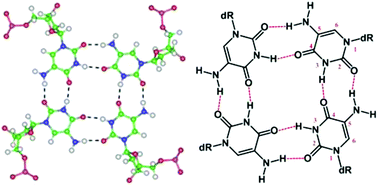A novel pyrimidine tetrad contributing to stabilize tetramolecular G-quadruplex structures†
Abstract
G-quadruplex structures formed by oligodeoxyribonucleotides TGGUNH2GGT (AM, UNH2 = 5-amino-2′-deoxyuridine), TGGUBrGGT (BR, UBr = 5-bromo-2′-deoxyuridine) and TGGTGGT (TH) have been investigated through circular dichroism, nuclear magnetic resonance, gel electrophoresis and molecular modeling techniques. Collected data indicate that all 7-mer oligonucleotides form tetramolecular parallel G-quadruplex structures with all residues adopting anti glycosidic bonds. In the case of AM, data suggest the occurrence of a novel UNH2-tetrad characterized by eight hydrogen bonds that stabilizes the G-quadruplex structure more efficiently than UBr- and T-tetrads.


 Please wait while we load your content...
Please wait while we load your content...